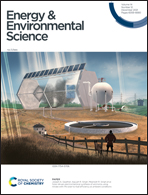Carbon dioxide and nitrogen reduction reactions using 2D transition metal dichalcogenide (TMDC) and carbide/nitride (MXene) catalysts
Abstract
Improving the carbon dioxide and nitrogen reduction reactions (CO2RR and NRR) can reduce anthropogenic greenhouse gas emissions while selectively producing chemicals needed for the fuel, plastic, and chemical industries. Efficient CO2RR can be used to replace fossil fuels as well as repurpose captured CO2, while new NRR pathways can be used to supplement or replace the energy intensive Haber–Bosch process for NH3 generation with no CO2 emissions. Therefore, this review article focuses on (photo)electrocatalytic and photocatalytic conversion of CO2 and N2 molecules into useful products, such as carbon monoxide, methanol, formic acid, and ammonia, using 2D transition metal dichalcogenides (TMDCs) and metal carbides/nitrides (MXenes). These highly tunable 2D catalysts will be evaluated for their ability to selectively and efficiently undergo CO2RR and NRR by controlling defects, phases, edge sites, interfaces, and functional groups. We first address the CO2RR and NRR challenges, with a particular focus on theoretical mechanisms and minimum energy pathways. We follow this discussion with a detailed review of state-of-the-art 2D TMDC and MXene experimental catalysts for CO2RR and NRR (photo)electrocatalytic and photocatalytic reactions, and then address areas of opportunity for these catalytic reactions.



 Please wait while we load your content...
Please wait while we load your content...